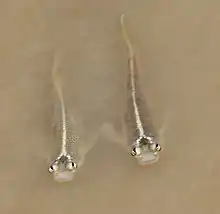Four-eyed fish
The four-eyed fishes are a genus, Anableps, of fishes in the family Anablepidae. They have eyes raised above the top of the head and divided in two different parts, so that they can see below and above the water surface at the same time.
| Four-eyed fish | |
|---|---|
 | |
| A. anableps, Dégrad des Cannes, French Guiana | |
| Scientific classification | |
| Kingdom: | Animalia |
| Phylum: | Chordata |
| Class: | Actinopterygii |
| Order: | Cyprinodontiformes |
| Family: | Anablepidae |
| Subfamily: | Anablepinae |
| Genus: | Anableps Scopoli, 1777 |
| Type species | |
| Cobitis anableps Linnaeus, 1758 | |
| Species | |
|
See text | |
Like their relatives, the onesided livebearers, four-eyed fishes mate only on one side, right-"handed" males with left-"handed" females and vice versa.
These fish inhabit fresh and brackish water and are only rarely coastal marine. They originate in lowlands in southern Mexico to Honduras and northern South America.[1]
Species
There are currently three recognized species in this genus:[2]
- Anableps anableps (Linnaeus, 1758) (Largescale foureyes)
- Anableps dowei T. N. Gill, 1861 (Pacific foureyed fish)
- Anableps microlepis J. P. Müller & Troschel, 1844 (Foureyes)
Physical characteristics

The maximum length of four-eyed fishes is up to 32 cm TL in A. microlepis, making this species the largest in the order Cyprinidontiformes.[3]
Four-eyed fish have only two eyes, but the eyes are specially adapted for their surface-dwelling lifestyle. In early development, the four-eyed fish’s frontal bone expands dorsally allowing the eyes to be positioned on top of their head and appear bulging.[4] This allows the fish to simultaneously see above and below the water as it floats at the surface. The eyes are divided into dorsal and ventral halves, separated by a pigmented strip of tissue. Each eye has two pupils and two corneas filtering light onto one lens, refracting onto separate hemiretinas and processed through one optic disc.[5] The upper (ventral) half of the eye is adapted for vision in air, the lower (dorsal) half for vision in water.[1] The lens of the eye also changes in thickness top to bottom to account for the difference in the refractive indices of air versus water. The ventral hemiretina is characterized by thicker cell layers containing more sensory neurons and an increased visual acuity compared to the dorsal hemiretina.[4]
Four-eyed fish are livebearers. Along with their sister genus Jenynsia they mate on one side only, right-"handed" males with left-"handed" females and vice versa.[6] The male has specialized anal rays which are greatly elongated and fused into a tube called a gonopodium associated with the sperm duct which he uses as an intromittent organ to deliver sperm to the female.
Behavior
.jpg.webp)
Four-eyed fish spend most of their time at the surface of the water. Their diet mostly consists of terrestrial insects which are readily available at the surface, however they may consume other foods such as other invertebrates, diatoms, and small fishes.[7]
The fish will group differently depending on the species. A. anableps commonly congregates in schools.[7] A. microlepis also is gregarious, but restricts its schools to about a dozen individuals; it is also recorded to be found singly or as couples.[3]
A. anableps is also known for the ability to survive out of water exposed to air, such as during low tide.[7]
See also
- Rhinomugil, a genus of Asian and Australian mullets popularly known as false four-eyed fish
- Brownsnout spookfish, a fish with each eye divided into a part that works refractor and a part that works reflector
References
- Nelson, Joseph, S. (2006). Fishes of the World. John Wiley & Sons, Inc. ISBN 0-471-25031-7.
- Froese, Rainer and Pauly, Daniel, eds. (2012). Species of Anableps in FishBase. August 2012 version.
- Froese, Rainer and Pauly, Daniel, eds. (2007). "Anableps microlepis" in FishBase. Mar 2007 version.
- Perez, Louise N.; Lorena, Jamily; Costa, Carinne M.; Araujo, Maysa S.; Frota-Lima, Gabriela N.; Matos-Rodrigues, Gabriel E.; Martins, Rodrigo A. P.; Mattox, George M. T.; Schneider, Patricia N. (2017-04-12). "Eye development in the four-eyed fish Anableps anableps : cranial and retinal adaptations to simultaneous aerial and aquatic vision". Proceedings of the Royal Society B: Biological Sciences. 284 (1852): 20170157. doi:10.1098/rspb.2017.0157. ISSN 0962-8452. PMC 5394668. PMID 28381624.
- Oliveira, Francisco Gilberto; Coimbra, João Paulo; Yamada, Elizabeth Sumi; Montag, Luciano Fogaça De Assis; Nascimento, Francyllena L.; Oliveira, Valéria A.; Mota, Diógenes Luís Da; Bittencourt, Alexandre Motta; Silva, Valdir Luna Da; Costa, Belmira Lara Da Silveira Andrade Da (November 2006). "Topographic analysis of the ganglion cell layer in the retina of the four-eyed fish Anableps anableps". Visual Neuroscience. 23 (6): 879–886. doi:10.1017/S0952523806230232. ISSN 0952-5238.
- "Four Eyes and More, the Family Anablepidae". WetWebMedia.com. Retrieved 2007-03-30.
- Froese, Rainer and Pauly, Daniel, eds. (2007). "Anableps anableps" in FishBase. Mar 2007 version.
External links
- "Anableps". Integrated Taxonomic Information System. Retrieved 6 June 2006.
